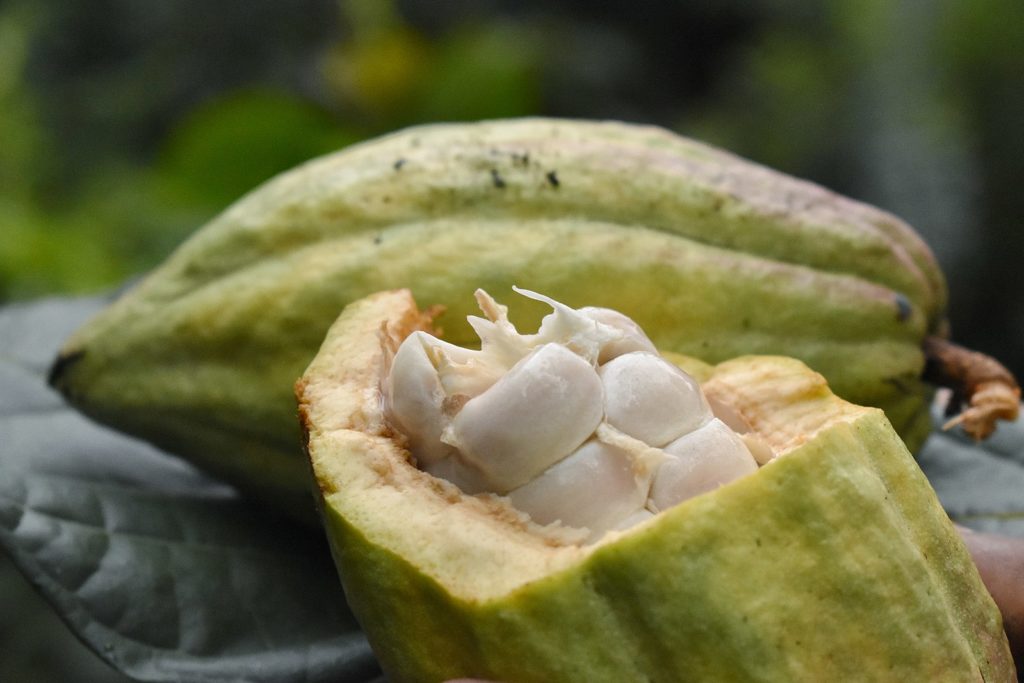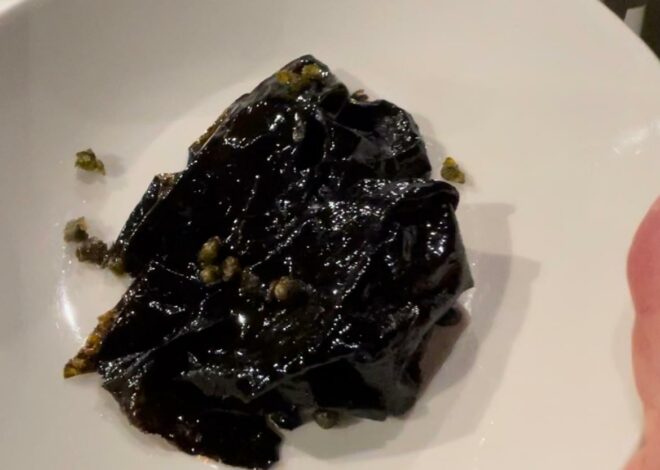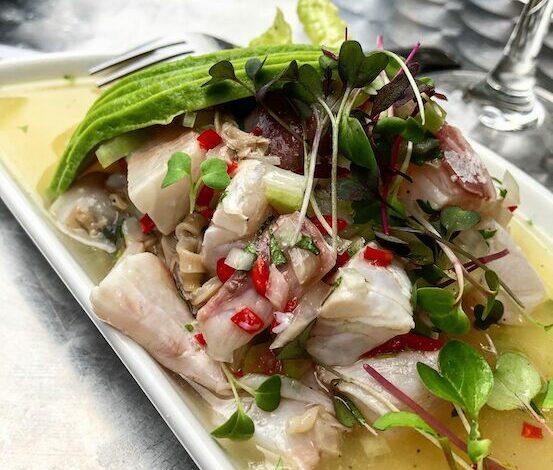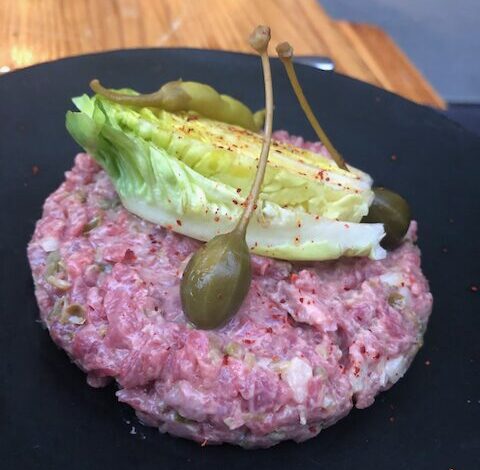
An Amazonian Private Chef’s Chronicle: Pt. 2 – Dancing with Death
Growing up in Caracas makes you tough, street-smart, and quick. Even more so now than when I was coming up. They say that the need for resources is the mother of invention. Training in Venezuelan restaurant kitchens is like getting a master’s degree in these qualities.
My first job was at a French restaurant, and the sous chef there was Rubén Dario Martínez. He also was the tournant, which means he filled in for anyone on their day off. His kitchen manners were ruthless; he commanded it like a pirate captain.

Our services were true battles, with up to 400 diners to serve. Rubén is the fastest and most resourceful chef I’ve ever seen. If there was no strainer, he’d use a perforated tray. If there was no coffee ice cream, he’d order two espressos and mix them on the spot with vanilla ice cream. And if there was no oil—yes, you read that right, oil, because already by 2004, there were days when oil was scarce all over the city—Rubén would crack open canned peppers in oil and dip the fish fillets in it before throwing them into a pan. Rubén didn’t think; he solved problems, making these solutions seem obvious and those who couldn’t see them, foolish.

There I was, in the heart of the Amazon, contemplating how to make my solution seem obvious.
We woke up at 5 am, and I went over my supplies. In the worst-case scenario, I had enough rice and pasta to survive the next few days. I probably overreacted. One of the princesses was already awake, engaged in a heated debate about stock trading through a satellite phone. What a way to waste a stay in the Madidi, the most biodiverse place on the planet.
Not far from there stood the bodyguard, always with a cigarette dangling from his lips, reminding me of Jean Reno in “Léon: The Professional.” The photographer was the most down-to-earth member of the entourage, a young Brit switching lenses with the precision of a war photographer, capturing memorable moments of his clients. The rafting instructor, who had been relatively calm until now, had let loose upon the arrival of his adored princesses. He sported outrageously bright colors and couldn’t stop trying to grab everyone’s attention. He was the Court Jester.
The other princess, the cousin of the one who was truly the daughter of a great sultan, couldn’t bring herself to look anyone in the eye, or more likely, she refrained from doing so out of obedience to some ancient belief. Especially not me. I imagined it had something to do with castes. My mediocre mortality was not to be worthy of her presence.
My mind continued to race, scanning scenarios and possible solutions to the meat shortage. Nobody would starve, but feeding Arab princesses solely with pasta al aglio might pose an image problem for my entire team back in the city of La Paz. In situations like these, you have to work with what you have at hand. So, I looked around. I glanced at that old sugar mill with a vehicle nearby when suddenly, I had an epiphany. A Newtonian spark illuminated my mind. There were chickens and ducks on that chacra.
“If the chickens are alive, there’s no need to refrigerate them.” A relieved chuckle overcame me.
“Go to Mr. Huidobro’s chacra and buy all the chickens he has. Pay whatever it takes. We’ll set sail after breakfast.”
As a seasoned hospitality veteran, I knew how to keep all these mishaps hidden from our guests. My smile never left my face as I served breakfast on time.
The guides didn’t take long to arrive, carrying potato sacks containing three chickens and three ducks. I asked them to provide water and food for my prisoners.

The first few hours downstream were relatively calm. We cruised at a leisurely pace, marveling at the imposing and magical vegetation surrounding us. At the first stop, there were fields belonging to Bolivia’s leading cocoa company, and we helped ourselves to some cocoa pods— one “forastero” and one “criollo”—to compare their qualities. The forastero cocoa is more efficient in terms of production; the fruit is larger and contains more beans. In contrast, the criollo is quite the opposite, but it possesses a magic in its aroma that its capitalist cousin just can’t replicate.
Eating raw cocoa is quite a revelation. You often see the raw beans as white due to the pulp around them, but when you slice them, they’re a color resembling purple, which dries into its distinctive brown. Tasting it reminds me of fresh almonds but with their own fruity nuances. It’s like understanding the power of fermentation in reverse—how it can transform a simple fruit into the complexity of chocolate. To me, it made sense to slice those beans and add them to a basic salad, using the surviving lettuce I had on hand. The princesses had never tasted fresh cocoa before. they liked it.

From there, we set sail to what would be our first campsite. On the next day’s journey, we encountered the main “malpaso” of the trip, which is what they called the critical points along the route. All the rafts parked, and the guides climbed a rock from which the waterfall that needed to be crossed could be seen clearly. As they deliberated, one of the guides who had stayed by my side said to me,
“The problem with this passage is a rock. One day, it’ll need to be dynamited. Once, a group of Israelis passed through here. Only the life jacket of one of them resurfaced. They searched with helicopters for weeks, but he never turned up. This is the trickiest passage on the route.”

With that introduction, our guides returned, ready to tackle the waterfall. It stood as tall as a one-story building, yet the unique challenge lay in the guides’ need to navigate a zigzag path, deftly avoiding huge rocks. We clung to the raft’s ropes like cats, wearing life vests but no helmets, trusting that these river pirates were indestructible and knew what they were doing. We embarked on our descent. It felt like riding a roller coaster. We turned to the right, then to the left, followed by another right, and another, like a perpetual circle of life. As we hit the bottom, the raft submerged and resurfaced from the rapids, leaving us completely drenched from head to toe. We turned to look at the other boats following us. The princesses were in dinghies, along with the bodyguard and the rafting instructor.
Everything happened very quickly. Suddenly, the pilot, who had mocked Mamani, fell overboard. The owner of the agency, who was on my raft, took the helm. The fallen pilot, without any hesitation, swam through the rocks and got back on the raft, taking control again. As I glanced to my right, the owner of the agency fell into the water. I pulled him out immediately. Then, as I turned to my left, no! The chickens! I rescued them too.
When we looked back, the bodyguard had fallen into the water. Unlike Scarface, he began to scream in absolute panic. I remembered the instructions from the rafting instructor and handed the owner of the agency the rescue rope package. He threw it as we had been instructed, bringing it closer to our raft, and rescuing him. The rafting instructor managed to flip his dinghy back over and get back on. It was undoubtedly the most Indiana Jones moment of my life.
From there, we arrived at the next riverside campsite. As the cook, I had to travel in the fastest boats to get there first. It was me and the owner of the agency, who diligently set up the portable toilets and the princesses’ tents before their arrival.
Once the rest of the group arrived, they began setting up the camp. The guides had brought their own food and were by the river’s edge, fishing. Perfect, I thought, I could ask them for some fish. Upon arrival, I stumbled upon a picturesque scene. Scarface, who had been mocking Mamani, had lost his dentures during the “malpaso,” and he was missing all his upper teeth. Now, he was the target of sharp ridicule. Mamani didn’t say a word, but his smile savored the taste of karma. The other guides were certainly making fun of him.
“Look, here we have a pacu (a river fish with large teeth). ‘Why don’t you put on its teeth?'”
That night, I lost my virginity to death. Mamani insisted he could do it alone, but I felt it was something I had to do. In the northern forests of Sweden, at his iconic yet now-closed 12-seat restaurant, Fäviken, Magnus Nilsson had an unconventional way of initiating culinary newcomers: by having them dispatch a duck by snapping its neck. Since the moment humans began consuming meat, we’ve had a relationship with death, one that many have lost direct contact with, imagining that chicken breasts grow in refrigerators. Understanding the process of slaughter is essential to understanding food.
Mamani showed me first. They were half sized chickens and ducks. They were cute, docile, friendly, emitting gentle, vibrant sounds of life. Mamani’s technique involved grabbing both wings and legs with one hand at the same time.
“Hold them firmly, don’t let them beat you” he advised.
On the riverbank, Mamani placed the neck of the first duck against a stone. It was my turn. It’s a well-known fact that everyone screws up on their first go at something like this. I slid my Global GS-11 knife along the throat, in reaction, the wings slipped from my hands, leaving me only with the feet. The decapitated bird began to flutter, the whole body started to thrash wildly, splattering showers of blood onto the rocks, onto the river, onto the sand. I pointed it forward, holding the feet tightly in my hands, so it wouldn’t splash on me. It would take an endless minute for the bird to stop moving. Something died within me.
“Next one” I said.

We went to the kitchen tent. Mamani plucked the birds with boiling water. We had 3 ducks and 3 chickens. I handled the rest of the preparations. As I dismantled the birds, I remember the strange sensation of working with warm poultry pieces that had never been refrigerated. I used the bones to make two different broths. I recall making something akin to a barley risotto. Dinner was a success, and when I mentioned the experience, one of the princesses said,
“Oh, how exciting. You should have told me; I would have liked to have had an experience like that too.”
The next morning, Scarface led me to a riverbank.
“Cook, come here. Look what I’ve got for you.”
He showed me a small pool made of rocks, and inside it, there were about 6 large live fish swimming. He pulled a nylon thread and pulled out one of the fish. He had them tied up, swimming alive. In the Venezuelan Amazon, I witnessed a fishing technique that involves carefully applying a substance to the water to anesthetize the fish, causing them to float to the surface, where they can be easily caught by hand.
“How are we taking them?”
“Tied up,” he said laughing. “The river’s water is cold.”
At the next stop, I arrived and prepared some tiraditos and grilled those fish.

For the last meal, I was exhausted. My cooler was filled with spoiled food. I had to offer a generous amount of it to the Pachamama. After five days of daily meal preparations, camp setups and teardowns, and only 4 hours of sleep each night, I simply couldn’t go on. We were at the final point, and I was trying to get some rest. Cesar, the guide who had grown up there, told me that we would be staying in a hotel that night.
“Ghinsberg raised funds in Israel and, in return for being rescued, he financed and established a luxury hotel and training center in the Chalalan community. It’s where they’ll come to pick us up, and where we’ll sleep. Young people from the community learn about hospitality, tourism, languages, and gastronomy.”

In a month’s time, I would return through a one-day journey to that same hotel for an Amazonian forest gastronomy congress with a select group of international chefs. A fleet of motorboats from the Chalalan Resort arrived, and it felt like the final rescue scene from a survival adventure film.
to be continued…
Image Attributions:
Pacu Fish
https://www.flickr.com/photos/canaldoprodutor/44335315295
Cocoa
https://commons.wikimedia.org/wiki/File:Cocoa_fruit_4.jpg





